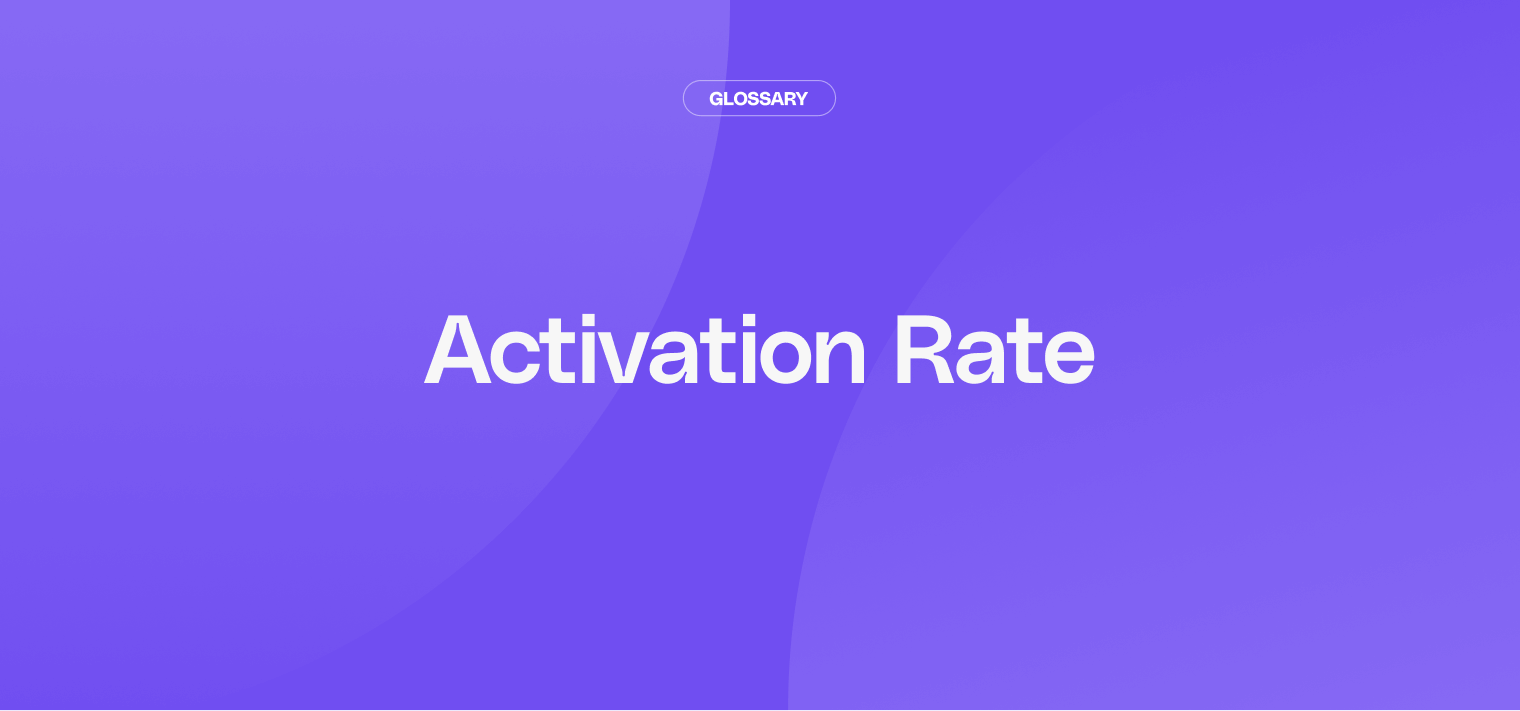In today's data-driven business landscape, measuring and understanding user behavior is crucial for success. One key metric that companies rely on and which is key for referral programs is the activation rate.
But what exactly is activation rate? In this article, we will dive deep into the concept of activation rate, its importance, components, industry-specific applications, and strategies to improve it.
Key takeaways:
- Definition and Importance: Activation rate is the percentage of users who complete specific actions to fully engage with a product or service. This metric is crucial for understanding user engagement and gauging the effectiveness of a product or service or also a marketing campaign.
- Components and Calculation: The rate is influenced by factors like clear onboarding instructions, ease of use, perceived product value, and personalization. It's calculated by dividing the number of users who complete the necessary actions by the total number of users, then multiplying by 100.
- Industry-Specific Applications: The rate of user activation varies across industries; in tech, it's focused on user engagement with the product, while in retail, it's about converting potential customers into active buyers.
- Strategies for Improvement: To increase the rate, businesses should simplify the onboarding process, clearly communicate the product's value, personalize the user experience, offer educational resources, and optimize the user interface.
- Impact on Business Metrics: A high rate is linked to better customer retention and can significantly influence revenue growth. It's a critical measure for evaluating the success of user onboarding and conversion efforts.
Understanding the concept of activation rate
Activation rate is a metric that measures the percentage of users who have completed a specific action or set of actions necessary to achieve a desired outcome. It provides valuable insights into user engagement and the effectiveness of a product or service.
When it comes to understanding user behavior and the success of a product or service, the rate of customer activation plays a crucial role. It helps businesses determine whether users are actively engaging with their offerings and whether they are experiencing the full value of what is being provided.
By tracking the rate of user activation, companies can gain a deeper understanding of user engagement and make informed decisions to improve their product or service.
But what exactly does activation rate mean?
Definition and importance
Activation rate refers to the proportion of users who have taken the necessary steps to experience the full value of a product or service. These steps could include creating an account, completing an onboarding process, or initiating their first transaction.
This metric is a vital indicator of whether users are getting value from the product, and it plays a significant role in assessing growth and performance.
Understanding the importance of activation rate is crucial for businesses looking to optimize user engagement and drive growth.
By analyzing it, companies can identify any barriers or obstacles that may be preventing users from fully experiencing the value of their product or service. This insight allows businesses to make data-driven decisions to improve the user journey and increase the rate of customer activation.

The role of activation rate in business metrics
The rate of user activation serves as a fundamental building block in various business metrics. It is often used as a key performance indicator (KPI) to measure the success of user onboarding and conversion efforts.
It helps in identifying bottlenecks and areas for improvement within the user journey. By analyzing rate of activation alongside other metrics like customer retention and revenue growth, businesses can gain insights into the overall health and potential of their product or service.
When it comes to evaluating the success of a product or service, activation rate plays a crucial role in assessing growth and performance.
By tracking activation rate, businesses can understand how effectively they are converting users into active and engaged customers. This information can then be used to make informed decisions and implement strategies to improve the rate of customer activation.
This metric also provides valuable insights into user behavior and engagement. By analyzing the patterns and trends in activation rates, businesses can identify any areas where users may be dropping off or experiencing difficulties in the onboarding process. This information can then be used to optimize the user journey and improve overall user experience.
| Business Metric | Description | Impact of Higher Activation Rate |
|---|---|---|
| Customer Retention Rate | The percentage of customers who continue to use the product or service over a specific period. | Increases as engaged users are more likely to remain active and loyal. |
| Revenue Growth | The increase in a company's sales and income over time. | Accelerates as more activated users lead to higher usage and purchase rates. |
| Customer Lifetime Value (CLV) | The total revenue a business can expect from a single customer account. | Improves with higher activation rates, as engaged customers tend to spend more over their lifespan. |
| Referral Rate | The rate at which existing users refer new users to the product or service. | Increases as satisfied users are more likely to recommend the service to others. |
Components
Several factors contribute to the calculation and interpretation of activation rate. Let's explore the key elements influencing the rate of user activation and a step-by-step guide on how to calculate it.
Influencing factors
Activation rate is influenced by a multitude of factors, including the clarity of onboarding instructions, ease of use and visibility, the perceived value of the product, and the level of personalization offered. A seamless and intuitive user experience is crucial to driving higher rates of customer activation.
Calculating activation rate: a step-by-step guide
To calculate activation rate, you need to define the specific actions that constitute activation for your product or service.
Once defined, you can determine the number of users who have completed those actions within a given time period and divide it by the total number of users during the same period. Multiplying the result by 100 yields the activation rate percentage.

Activation rate in different industries
Different industries have unique considerations when it comes to activation rate. Let's examine how the rate impacts the technology and retail sectors.
Tech industry
In the fast-paced world of technology, activating new users is crucial for success. A high rate of user activation indicates that users are engaged and finding value in the product or service.
Tech companies often focus on streamlining the onboarding process, implementing targeted user education, and leveraging data-driven personalization to optimize their metrics.
Retail sector
In the retail sector, activation rate measures the effectiveness of converting potential customers into active buyers. Retailers strive to simplify the signup process, provide seamless shopping experiences, and offer incentives to encourage immediate user engagement.
Understanding the rate of customer activation in the retail space helps businesses strategize around customer retention, repeat purchases, and long-term loyalty.
Strategies to improve
Achieving a higher rate of customer activation requires ongoing optimization and a deep understanding of user behavior.
Let's explore strategies to increase activation and discuss common mistakes to avoid when trying to improve it.
Strategies for increasing activation rate
- Simplify Onboarding: Make the onboarding process as seamless and self-explanatory as possible, minimizing barriers to activation.
- Provide Clear Value Proposition: Clearly communicate the unique value and benefits users will experience by activating and using your product or service.
- Personalize the User Experience: Tailor the user experience to each user's needs and preferences to enhance engagement and encourage activation.
- Offer Guided Tours and Education: Provide guided tours, interactive tutorials, and educational resources to help users understand and navigate your product or service effectively.
- Optimize User Interface: Continuously improve the usability and intuitiveness of your interface, reducing friction and frustration for users.

Common mistakes to avoid
- Overwhelming Users with Information: Avoid bombarding users with excessive information during the onboarding process. Keep it concise and focused on the essentials.
- Lack of Incentives: Failing to provide incentives for users to activate or complete desired actions can hinder engagement and conversion.
- Complexity in User Interface: A complicated interface can lead to confusion and discourage users from activating.
- Neglecting User Feedback: Listen to user feedback and address pain points promptly. Ignoring user feedback can result in missed opportunities to improve activation rates.
Measuring the impact
Understanding the correlation between activation and other crucial business metrics is essential in assessing the success and growth potential of a product or service.
The relationship between activation rate and customer retention
Activation and customer retention are closely linked. A high activation rate indicates that users are more likely to continue using the product or service, leading to higher customer retention rates.
By improving the rate of customer activation, businesses can increase the chances of retaining satisfied and engaged customers over the long term.
How activation rate affects revenue growth
A higher rate can significantly impact revenue growth. By activating more users and driving higher adoption rates, businesses can increase customer lifetime value, drive repeat purchases, and expand their customer base.
The optimization can directly contribute to sustainable revenue growth for businesses.
As businesses strive for growth and success, understanding and optimizing the rate of customer activation is of paramount importance.
By analyzing key components, industry-specific applications, and strategies to improve the rate rate of customer activation, businesses can create a solid foundation for user engagement, retention, and revenue growth.
Unlock your product's viral growth with Cello
Maximize your activation rate and transform users into powerful advocates for your SaaS product with Cello. Our peer-to-peer referral program is designed to integrate seamlessly, making it the easiest way to leverage user-led growth and see immediate results. With minimal development time, no upfront costs, and a proven track record of increasing free to paid conversions, Cello empowers you to create a frictionless sharing experience that rewards your users and boosts your bottom line. Don't miss out on harnessing the full potential of your user base. Book a demo today and witness how Cello can elevate your business growth in hours.
Resources
Related articles

7 Best B2B Referral Software (2025 Guide)
Which referral software should I choose? In the world of referral marketing, choosing the right ...

Scaling and Maintaining a B2B User Referral Program
Learn how to set the right incentives for B2B SaaS user referral programs

What are User Generated Content Growth Loops?
User Generated Growth (UGC) loop is a growth engine where users create content that attracts ...

